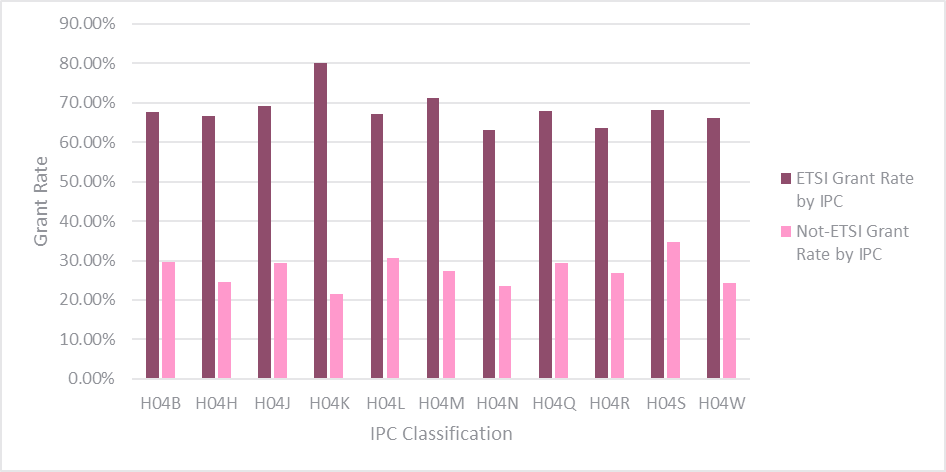
This blog is the first in a series in which we explore standards essential patents using patent data from the EPO.
Declaring a patent as a Standard Essentials Patent (SEP) means that the patent relates to a technology which is essential to implementing a technical standard. More information about this can be found in some of our previous blog posts here.
The Data
To begin answering the above question, we searched the EPO patent database to extract a dataset of all European patent applications filed between 1993 and 2021, where the application was classified into the International Patent Classification H04: “Electronic communication technique”. This dataset contains 730,641 patent applications.
From this dataset, we isolated 34,309 European patents or applications listed in the ETSI (European Telecommunications Standards Institute) IPR database. Each of these had been declared to be essential to at least one standard managed by ETSI, in accordance with ETSI’s IPR policy.
This gives us the following three datasets:
|
Dataset name |
Description |
Number of hits |
|
H04 dataset |
all European patents and applications classified in H04 |
730,641 |
|
ETSI dataset |
the subset of H04 which had been declared to ETSI |
34,309 |
|
not-ETSI dataset |
the remainder of H04 which was not declared to ETSI |
696,332 |
Our Initial Analysis
The first analysis we performed on the data was to investigate the grant rate at the EPO of applications declared to ETSI vs applications that were not. What we found was that:
• the average grant rate for the ETSI dataset is 66.70%; and
• the average grant rate for the not-ETSI dataset is 26.35%.
Therefore, an application declared to ETSI as standards essential is more than twice as likely to grant as compared to an application not declared to ETSI.
The plot below shows the grant rate for each H04 subclass for the ETIS and not-ETSI datasets.

It is clear from this plot that the higher grant rate for ETSI patents vs not-ETSI patent is consistent for each IPC subclass.
Two initial theories to explain the above results spring to mind:
- ETSI-declared patents are likely to have more value than non-SEPs thus leading proprietors to spend more money and “try harder” to get their patent applications granted; and
- given the nature of ETSI-declared patents, and the assumption of infringement, a narrower claim scope is more acceptable to patent proprietors thus leading to a higher likelihood of grant.
What's to come?
In subsequent blog posts we will delve further into the data to explore these theories as well as to look for other reasons as to why ETSI declared patent applications have such a significantly higher grant rate.
We will also examine the differences (and similarities) between the key patent proprietors in this space.
Our analysis is very much on-going, so please get in touch if you have a question which you think our data can answer!
About the authors
This blog was co-written by Tom Furnival and Rebecca Frith.
.png?width=105&height=105&name=headshot%20frame%20Hojae%20Lee-1%20(3).png)
Rebecca Frith
Rebecca is a trainee patent attorney working in our engineering team. Rebecca's expertise focuses on analogue and digital electronics, radar technology, secure hardware, particularly physically unclonable functions, radio and communications technology, software and firmware, machine learning and artificial intelligence, especially in relation to computer vision and privacy preserving applications
Tom is a Partner and Patent Attorney at Mewburn Ellis. He handles a wide range of patent work, including original drafting, prosecution and opposition, particularly defensive oppositions, in the engineering, electronics, computing and physics fields. Tom also advises on Freedom-to-Operate, infringement issues and registered designs.
Email: tom.furnival@mewburn.com
Sign up to our newsletter: Forward - news, insights and features
Our people
Our IP specialists work at all stage of the IP life cycle and provide strategic advice about patent, trade mark and registered designs, as well as any IP-related disputes and legal and commercial requirements.
Our peopleContact Us
We have an easily-accessible office in central London, as well as a number of regional offices throughout the UK and an office in Munich, Germany. We’d love to hear from you, so please get in touch.
Get in touch

